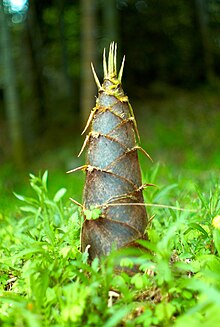Bamboo torture

Bamboo torture is a form of torture and execution where a bamboo shoot grows through the body of a victim. It was reportedly used in East and South Asian countries such as China, India, and especially Japan, but claims of its usage lack reliable evidence.
Recorded usage[edit]
A "Madras civilian", in his travel description from 1820s India, referred to this use of bamboo as a well-known punishment in Ceylon.[1] The use of live trees impaling people as they grow was recorded in the 19th century, when the Siamese used nipah palm sprouts in the same way as bamboo torture on the Malays during the 1821 Siamese invasion of Kedah, among other punishments.[2][3][4]
After World War II, stories circulated of Japanese soldiers inflicting "bamboo torture" upon Allied prisoners of war, securely tying the victim in place above a young bamboo shoot.[5] Over several days, the sharp, fast-growing shoot would first puncture, then completely penetrate the victim's body, eventually emerging through the other side.[6] In her Hakka Soul memoir, Chinese poet and author Woon-Ping Chin[7] mentions the "bamboo torture" as one of the tortures that locals believed the Japanese performed on POWs.[8]
The cast of the TV program MythBusters investigated bamboo torture in a 2008 episode and found that a bamboo shoot can penetrate through several inches of ballistic gelatin in three days. For research purposes, ballistic gelatin is considered comparable to human flesh, and the experiment thus supported the viability of this form of torture, though not its historical accuracy.[9][10]
References[edit]
- ^ Madras civilian (November 1827). Buckingham, J. S. (ed.). "Journey Across the Peninsula of India, from Madras to Bombay". Oriental Herald. 15, 47. London: Longman, Rees, Brown and Green: 293–299., p. 296
- ^ Osborn, Sherard (1861). My journal in Malayan waters. London: Routledge, Warne, and Routledge. pp. 190–94.
- ^ The Japan Science Review: Humanistic studies, Volumes 6-10, 1955 - Dissertations, Academic
- ^ Sejarah Pahang, Buyong bin Adil (Haji.), Dewan Bahasa dan Pustaka, Kementerian Pelajaran, Malaysia, 1984 - Pahang - 461 pages
- ^ The Other Empire: Literary Views of Japan from the Philippines, Singapore, and Malaysia. UP Press. 2008. ISBN 9789715425629.
- ^ Aldwinckle, Rod (8 August 2005). "Japanese Torture Techniques". bbc.co.uk. BBC. Retrieved 20 October 2019.
- ^ "Woon-Ping Chin". Archived from the original on 2013-12-04. Retrieved 2013-12-31.
- ^ Ping, Chin Woon (2008). Hakka Soul. NUS Press. p. 23. ISBN 978-9971-69-400-5.
- ^ "MythBusters Special 12: Viewer Special the Threequel". mythresults.com. Retrieved 20 October 2019.
- ^ Mehrotra, Akarsh (6 October 2017). "This Horrific Bamboo Torture Technique Is One Of The Worst The World Has Ever Seen". scoopwhoop.com. ScoopWhoop. Retrieved 20 October 2019.
